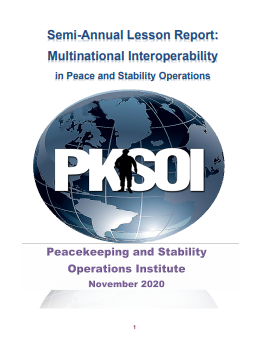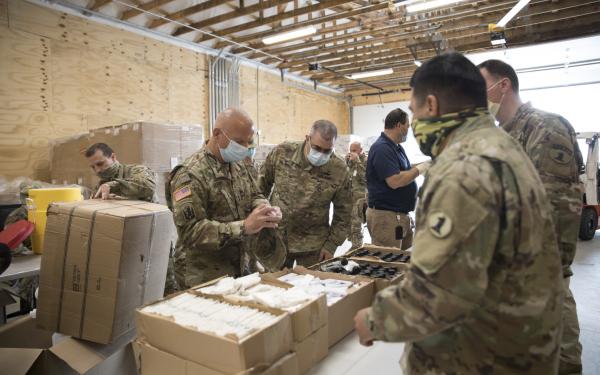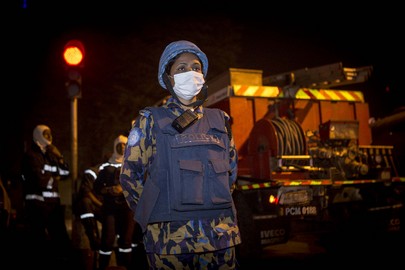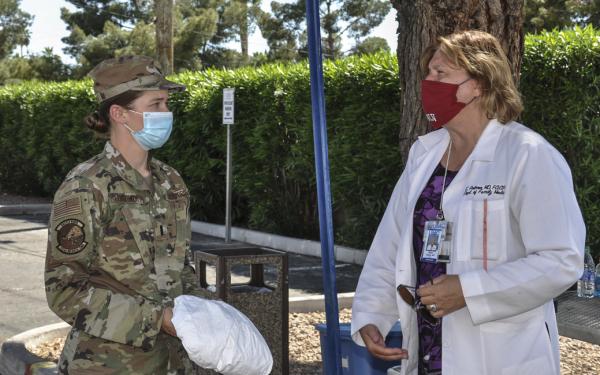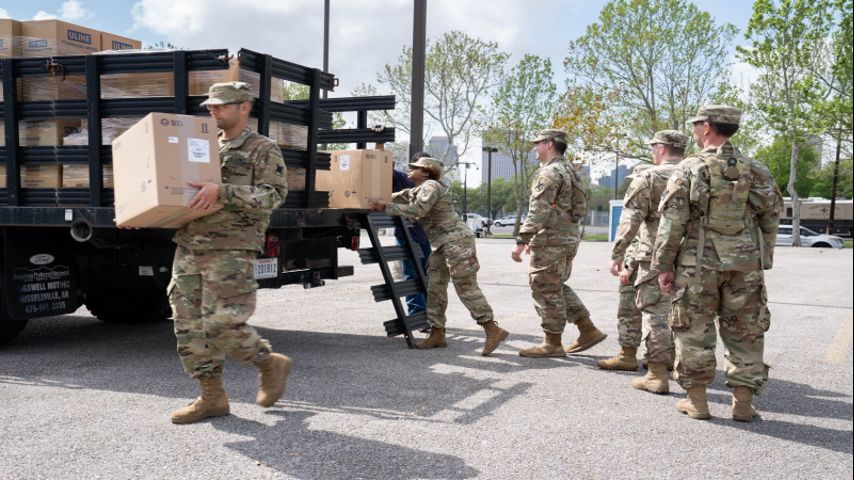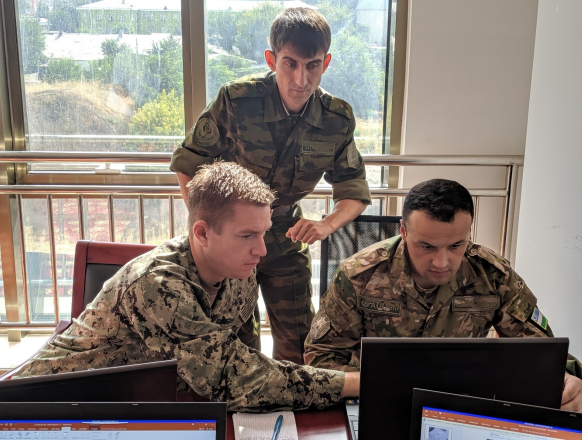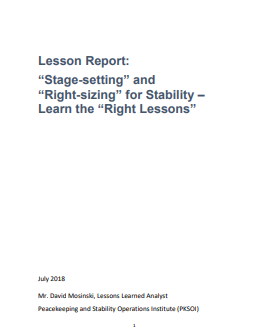Rule of Law during Pandemics

The current COVID-19 pandemic is a world-wide public health emergency that has resulted in a multitude of deaths and has severely impacted economies of every nation in the world. Currently, there have been over 20 million cases of COVID-19 worldwide. Establishing and maintaining peace and security in all countries, especially underdeveloped countries, are critical because effective governance and the rule of law are essential to managing COVID-19. Likewise, without effective rule of law, the pandemic has the potential to exacerbate corruption, lack of recourse to courts, and ineffective policing, thereby resulting in even more instability and hardship for the people who, in many cases, already face injustice and lack of meaningful legal redress. This PKSOI paper discusses ways the rule of law and the justice sector can effectively facilitate the response to COVID-19, while promoting stability, peace, and governance. Further, it outlines a way forward for strengthening rule of law.
What is Rule of Law
The rule of law is a principle which recognizes that all people, institutions, public and private entities, and the nation as a whole are accountable to clearly written laws that are publicly promulgated, equally enforced, independently adjudicated, and consistent with international human rights norms and standards. The rule of law is an end state that requires access to justice where people can seek and are afforded a remedy through formal and informal judicial institutions (United Nations, What is the Rule of Law?).
In 2005, President George W. Bush issued National Security Presidential Directive 44 (NSPD-44), which outlined the implementation of the rule of law as part of its assistance to other countries and its integration into military plans. This Executive Order recognized that the rule of law is integral to stability operations in accordance with Joint Publication 3-0, Operations (JP 3-0).
Without effective rule of law, nations cannot guarantee citizen rights and fundamental freedoms, thereby undermining enduring peace, security, and political stability. The UN recognizes the rule of law as “foundational to people’s access to public services, curbing corruption, restraining the abuse of power, and to establishing the social contract between people and the state” (UN, What is the Rule of Law?). Along with other government institutions, pandemics can fracture judicial mechanisms, resulting in unchecked violence, virulent corruption, and rampant human rights abuses. Under these circumstances, the rule of law collapses, which leads to protracted instability.

How Pandemics Challenge the Rule of Law
COVID-19 is the most disruptive pandemic since the 1918 Spanish Flu, impacting the economic, political, and social infrastructures of every country in the world. Pandemics like COVID-19 cause significant economic, social, and political disruption to the equilibrium of effective, efficient, inclusive, and responsive governance. If the rule of law is weak, businesses and citizens cannot function effectively, thus increasing the potential for violence and violations of human rights.
In today’s modern era, epidemics like with Ebola, SARS, MERS, and COVID 19 have the ability to spread more quickly because of increased global travel, urbanization, changes in land use, and greater exploitation of the natural environment (African Risk Capacity 2016). These trends will continue and intensify, causing governance in fragile nations to absorb the consequences and suffer the effects epidemics if not prepared.
Pandemics like COVID-19 especially impact judicial systems and rule of law in three key ways. First, nations must have effective legal frameworks that include public health laws consistent with the World Health Organization’s (WHO) mandates. Countries must be able to implement emergency measures, respected by the people, to protect them from the spread of the disease. For example, laws and regulations requiring the use of masks, quarantines, and testing procedures contribute to the effective medical response to the pandemic, and ultimately save lives. Governments that lack the ability to implement effective countermeasures cannot manage the spread of COVID-19 competently.
Second, the rule of law creates security for people, especially in fragile and underdeveloped nations. Government responses to pandemics require limits on freedoms of movement, such as quarantines and border closures. Effective rule of law seeks to reduce crime that has a disproportionate impact on the poor, women, elderly, children, and other marginalized people in less developed countries. For example, COVID-19 has caused economic contraction, financial straits for labor, and prolonged quarantining, leading to reported increases of domestic violence on women. Judicial institutions and courts must remain available to adjudicate crime and domestic violence on people and families.
Third, the rule of law helps nations recover from the effects of the pandemic because stronger government institutions can ensure the safety and security of citizens and property. Timely resolution of disputes minimizes violence and ensures reliance on the processes of an independent judiciary.
During pandemics, countries have the obligation to ensure that courts remain available to provide fair trials by an impartial court and effective remedies for litigants. Courts also play an essential role in securing the rule of law by ensuring other branches of government respect the law. For instance, pandemics can create situations for political abuses and usurpation of power by an executive leader or by the legislature.
Evidence and recent studies suggest that epidemics and pandemics can amplify existing political tensions and spark unrest, particularly in the governance of fragile states with legacies of violence and weak institutions. During the 2014 West Africa Ebola epidemic, steps taken to mitigate disease transmission, such as quarantines and curfews by security forces, were viewed with suspicion by segments of the public and opposition political leaders. This led directly to riots and violent clashes with security forces (McCoy 2014). In Liberia, political tensions among warring factions reemerged early in the epidemic and were linked with threats to healthcare workers, as well as attacks on governance institutions, specifically public health personnel and facilities. The Ebola epidemic amplified political tensions in Guinea, Liberia, and Sierra Leone. In Sierra Leone, quarantines in opposition-dominated regions were delayed because of concerns that it would be seen as politically motivated (ICG 2015). A pandemic in countries with high levels of political polarization, recent civil wars, or weak government institutions can create overwhelming pressure and political tensions, impacting the governance structure of the nation.
Pandemics threaten the operations of courts, with dramatic consequences. In many countries, including developing countries, courts are closed for all matters, except those deemed “urgent” (International Commissions of Jurists). Routine disputes are shelved for months while only those cases involving irreparable harm are adjudicated, often by video and other platforms, rather than in-person hearings. In many proceedings, litigants, attorneys, and persons arrested and detained normally appear in person before a court, especially for a preliminary hearing. However, with increased reliance on telephone and video-conferencing, the pandemic frustrates the ability of courts to administer justice effectively.

Without the ability of courts to supervise justice effectively, criminals are released from prisons to prevent the spread of COVID-19, and police are not arresting or detaining individuals accused of minor offenses. Lack of legitimate court supervision also is an invitation for illicit organizations. The UN mission in Congo provided support to the prosecution of those who committed serious crimes. As the UN recognized, the absence of effective justice systems across remote areas of Congo, where many of the crimes occurred, has been an underlying cause of the violence. Providing effective justice instilled confidence in state actors and led to decreases in violations committed by armed groups, the national armed forces, and the police (UN Chronicle).
Terrorists find their greatest safe haven in countries where governments cannot or will not control their territory. Pandemics are an invitation for organized criminal groups to create networks when governments are complicit (corruption) or unable to take steps to mitigate the threats (inadequate security). The missing link in all of these cases is the absence of the rule of law.
Military Doctrine Requires Support for Rule of Law
Department of Defense Directive 3000.05, Stabilization, states that stabilization is an inherently political endeavor that requires aligning U.S Government (USG) efforts—diplomatic engagement, foreign assistance, and defense—to create conditions in which locally legitimate authorities and systems can peacefully manage conflict and prevent violence (DoDD 3000.05, p. 3). While the Department of State is the overall lead for Governance and other stabilization efforts, the US military is responsible for assisting other US government agencies, mainly the Department of State, to assist foreign nations and their people to share, access, and voice their opinion through non-violent processes (JP 3-07).
Military operations must incorporate stabilization planning across all lines of effort as early as possible to shape operational design and strategic decisions. Stabilization requires sustained civil and military integration at the strategic, operational, and tactical levels to achieve unity of effort. This includes optimizing civil-military teams that can integrate key instruments of national power to complement allies and partners’ capabilities to achieve stabilization objectives. To that end, forces must be trained to conduct DoD’s core stabilization responsibilities, including the establishment of transitional public security to protect civilian populations when respect for and enforcement of rule of law is degraded (DoDD 3000.05, p. 11).
Thus, military doctrine recognizes that US forces can assist rule of law development by creating security for host nations. Rule of law objectives can only be attained after there is a safe and secure operational environment.
Way Forward
The United States and its military missions must take immediate action to address urgent dangers to mitigate major threats before they arise—and to sustain global support for rule of law. The following steps are recommended for providing support for the rule of law in fragile states, in cooperation with partner nations whose stability is in the US national interest. These steps are a composite outlined in JP3-07, FM 3-07 and UN publications:
- Support the rule of law with nations that enjoy true legitimacy and internal support for the system of government expressed voluntarily by the people.
- Help nations strengthen the legal and policy framework for managing COVID-19.
- Help implement creative solutions to ensure access to justice, such as assisting courts to hold outdoor hearings, video proceedings for some proceedings, and administrative proceedings to continue to resolve disputes, while safeguarding traditional principles of fairness and transparency.
- Advocate for the need to maintain the rule of law, to help countries develop and maintain their governance and institutions, and to help them adopt a culture of justice to protect the rights of people. The US military support elements could include, for example, judge advocate legal support to a recognized justice and dispute resolution system perceived as fair, who coordinate with other players in the rule of law area to optimize rule of law objectives.
Resources:
ARC (African Risk Capacity). 2016. “African Risk Capacity Strategic Framework 2016–2020.” Strategy and policy document, ARC, Johannesburg, South Africa.
ASPR (Assistant Secretary for Preparedness and Response). 2014. “Public Health and Medical Situational Awareness Strategy.” Strategy document for situational awareness implementation plan U.S. Department of Health and Human Services, Washington, DC.
Diamond J. 2009. Guns, Germs, and Steel: The Fates of Human Societies. New York: Norton.
McCoy T. 2014. “Why the Brutal Murder of Several Ebola Workers May Hint at More Violence to Come.” Washington Post, September 19.
Elbe S. 2002. “HIV/AIDS and the Changing Landscape of War in Africa.” International Security.
ICG (International Crisis Group). 2015. The Politics behind the Ebola Crisis. Crisis Group Africa Report 232, International Crisis Group, Brussels, October 28.
International Commission of Jurists, 5 May 2020. The Courts and COVID-19. ICJ Centre for the Independence of Judges & Lawyers.
National Security Presidential Directive/NSPD-44 (2005), available at https://www.fas.org/irp/offdocs/nspd/nspd-44.html.
United Nations, Economic and Social Commission for Asia and the Pacific, 2012, ‘What is Good Governance,” Bangkok, Thailand.
United Nations Chronicle, Strengthening the Rule of Law and Protection of Civilians in the Democratic Republic of the Congo.
United Nations, “What is the Rule of Law, https://www.un.org/ruleoflaw/what-is-the-rule-of-law/, June 10, 2020.
Joint Publication 3-07, 2016, Stability, Washington DC.
DoD Directive 3000.5, Stabilization, Office of the Under Secretary of Defense for Policy, December 13, 2018.

